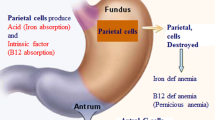Summary
It is proposed that the columnar epithelial tissue covering the inner surface of the small intestine is in a state of dynamic equilibrium. The total mass of the epithelial cells remains constant while the individual cells are continually lost and replaced. The size of the mass is estimated to be about 750 ml. If the life span of the cells is 3 days, the mass is maintained by the production of 250 ml. per day of new epithelial cells and the loss of an equal volume of old cells.
If these assumptions are correct one may predicate the existence of a disease of the small intestine which is the result of diminished mass of epithelial cells. This may come about through premature loss or destruction of the cells or because of insufficient production of new cells. The pathogenesis of anemia has been expressed in a similar fashion.
It is suggested that the distortions of the intestinal villi of the sort found in sprue, cholera, and celiac disease may represent a structural reaction to a diminished mass of columnar epithelial cells.
Similar content being viewed by others
References
Huff, R. L., andFeller, D. D. Relation of circulating red cell volume to body density and obesity.J. Clin. Invest. 35:1, 1956.
Crosby, W. H. The hemolytic states.Bull. New York Acad. Med. 30:27, 1954.
Crosby, W. H., andAkeroyd, J. H. The limit of hemoglobin synthesis in hereditary hemolytic anemia.Am. J. Med. 11:273, 1952.
Crosby, W. H., andConrad, M. E. Hereditary spherocytosis.Blood 15:662, 1960.
McMinn, R. M. H. The rate of renewal of intestinal epithelium in the cat.J. Anat. 88:527, 1954.
Crosby, W. H., andKugler, H. W. Intraluminal biopsy of the small intestine. The intestinal biopsy capsule.Am. J. Digest. Dis. 2:236, 1957.
Sullivan, B. H., Sprinz, H., andBatsakis, J. G. Peroral small bowel mucosal biopsy.J.A.M.A. 174:2200, 1960.
Bahr, P. H. A Report on Researches on Sprue in Ceylon 1912–1914. Cambridge, London, 1915.
Paulley, J. W. Observations on the aetiology of ideopathic steatorrhoea.Brit. M. J. 2:1318, 1954.
Butterworth, C. E., Smith, R. B. W., andPerez-Santiago, E. Pathological findings in jejunal specimens obtained by peroral intubation biopsy in patients with malabsorption.Proc. World Congress Gastroenterol. 1958, 1:629, Williams & Wilkins, Baltimore, 1959.
Gangarosa, E. J., Beisel, W. R., Benyajati, C., Sprinz, H., andPiyaratin, P. The nature of the gastrointestinal lesion in Asiatic cholera and its relation to pathogenesis: A biopsy study.Am. J. Trop. Med. Hyg. 9:125, 1960.
Doniach, I., andShiner, M. Histopathology of the stomach in pernicious anaemia and jejunum in steatorrhoea.Brit. J. Radiol. 33:238, 1960.
Author information
Authors and Affiliations
Rights and permissions
About this article
Cite this article
Crosby, W.H. A concept of the pathogenesis of anemia applied to disorders of the intestinal mucosa. Digest Dis Sci 6, 492–498 (1961). https://doi.org/10.1007/BF02231066
Issue Date:
DOI: https://doi.org/10.1007/BF02231066




